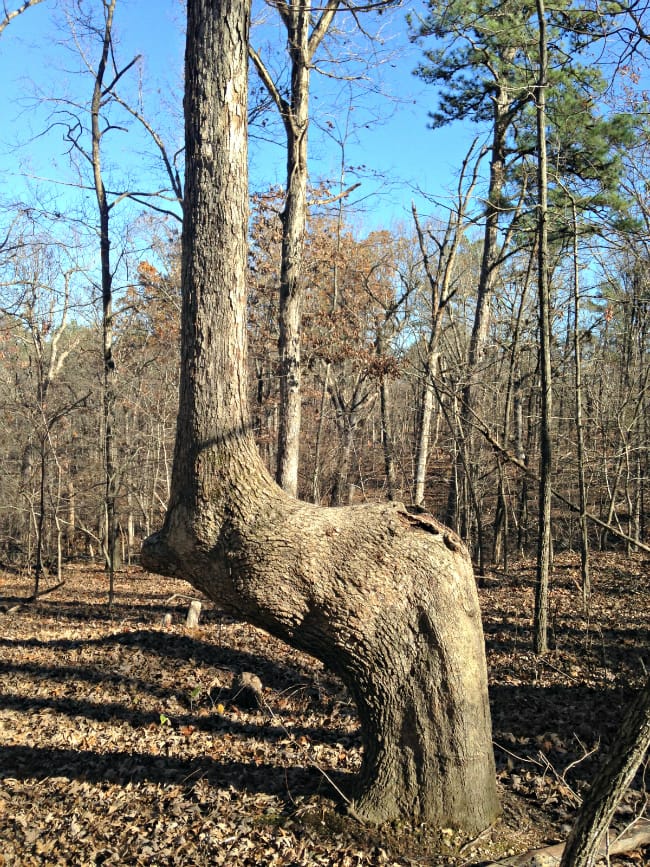

Uh oh...
It appears that you're using a severely outdated version of Safari on Windows. Many features won't work correctly, and functionality can't be guaranteed. Please try viewing this website in Edge, Mozilla, Chrome, or another modern browser. Sorry for any inconvenience this may have caused!
Read More about this safari issue.

Two weeks ago, I was on my first-ever four-wheeler ride around a beautiful piece of property near Huntsville, Arkansas. My host slowed the vehicle and pointed to a tree whose trunk bent into an awkward L pattern before rising toward the sky. “That’s one of my signal trees,” she said proudly. “I have three on my property.”
I’ve run across signal trees before while hiking through Arkansas. These trees are rumored to be the remains of a trail marker system created by Native Americans before roads existed as a way to mark campgrounds, water and other important locations. But are the tales true?
Signal trees, also called trail marker trees or thong trees, have been found in 39 states and Canada. In 2007, a nonprofit group called Mountain Stewards, based in Georgia, decided to start documenting the location of as many trees as possible before they disappeared. The search began at Arkansas’s-own Hobbs State Park, where trail tree enthusiasts gathered to share information. Since that time, over 1,760 trees have been documented, many of these in Arkansas.

Many Native American tribes used the trail tree marker system, but each tribe had its own way of shaping trees. In Arkansas, the trees are mostly hardwood trees like white oak which will maintain their shape and have a long life span. These trees, called day stars by the Cherokees because they were easy to track in daylight through the forests, were tied down with a leather thong to permanently change the tree’s shape as it grew. Trees could be shaped differently to indicate a ceremonial site or a navigational marker.
Trail marker trails can be found across the state, but according to the Mountain Stewards’ research, they cluster in the northwest quarter of Arkansas and across the Missouri border. Another cluster is located on the Southeastern border with Louisiana. The trees in Arkansas closely mirror the shaping of trees in Georgia and North and South Carolina. For this reason, the Mountain Stewards believe the trees are a product of the Cherokee Tribe. Some Cherokees began migrating from their homeland on the East Coast after the Revolutionary War, but before forced relocation through the Indian Removal Act. These Cherokee could be responsible for the signal trees in Arkansas.

When Hobbs State Park employee Al Knox noticed nearly two dozen trees in the park that resembled signal trees, he alerted the Mountain Stewards and Dennis Downes, who has spent much of his life researching these unusual trees. Downes has traveled to many states to verify trail marker trees. He believes many trees in Arkansas are of Native American origin, but not all agree and verifying trail marker trees can be tough.
The Texas Historic Tree Coalition uses the following guidelines to verify a trail marker tree. The tree must be a native species to the area, most often a hardwood, which will bend as a sapling, but will also live many years. Check for any scars near the bends in the tree. Some trees will have scars from being tied down while being shaped. The trees often have a sharp bend a few feet off the ground and run parallel to the ground for several feet before bending up toward the sky. Most trail marker trees will have a round knob, or nose, on the end of the bend to indicate the direction the tree is pointing. Others will have bumps on the beginning of the bend where objects were inserted under the bark to create other markers. Many trees are found in areas known for Native American habitation and are often located near major landmarks such as rivers and other water sources, or a known trail. Finally, the trees must be at least 150 years old to qualify.

I met with Knox for an afternoon tromp through Hobbs to check out some of the trees he’s identified as possible signal trees. We admired a white oak right off the entrance to Pigeon Roost Trail, one of the park’s most popular hiking trails. Al pulled out his compass to show me how the nose of the tree points directly north. We also visited a tree that points toward a spring and another that is slowly decaying, though its signature bend is still visible. The fragility of the trees is one reason the Mountain Stewards want to catalog as many signal trees as possible. They won’t be around forever. The Mountain Stewards are also interested to see if a national trail system emerges once they have located trees across the United States.
Those who doubt the origin of trail marker trees point to natural explanations for the unusual bends in these trees. Ice can weigh down young saplings enough to permanently change the shape of the tree. Trees can be damaged in storms, or even by other trees that fall on them. These events can explain why some appear to be trail trees at first but fail to qualify. Many of these trees simply aren’t old enough to meet the 150-year mark commonly used to denote a trail tree. To complicate matters, some believe pioneers adopted the method of forming trail trees as they moved into new territory, making it more difficult to ascertain which trees were truly formed by local tribes.

Despite the reservations of some, the idea of trail marker trees persists, and many tribes acknowledge their existence as an important part of Native American history. So the next time you’re wandering through the woods of Arkansas and spot an unusually shaped tree, you just might be seeing a part of Arkansas history.
If you would like to report the location of Arkansas signal trees, you can contact the Mountain Stewards through their website at www.mountainstewards.org.
We do the work.
You check your email.
Sign up for our weekly e-news.
Get stories sent straight to your inbox!












 Leave a Reply
Leave a Reply
Hello, I have a tree on my property that resembles a trail tree. I was even told by the previous owner that it has been authenticated. I don’t know how true this is but it’s in Edgemont, Arkansas. Unsure how to check but thought I would reach out to yall. Thanks, Darren
I Know of one in ozark ark and it’s so awesome . There are alot of them around here I guess since the mulberry river is near here.